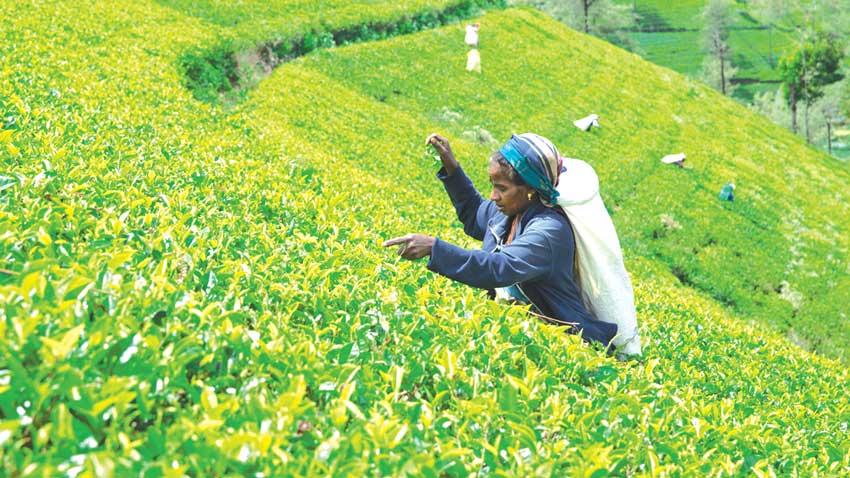28 Jul 2021 - {{hitsCtrl.values.hits}}

 During the last 18 months, we have seen an excellent performance by the Sri Lankan tea industry, especially due to the efforts by the Ceylon Tea promoters, exporters and producers, who have taken up the challenges such as stiff competition from low-cost supplies of other origin teas, high freight charges and difficulties in arranging logistics due to stringent health precautionary measures under COVID-19; even foreign and local media have commended the Sri Lankan tea industry achievements.
During the last 18 months, we have seen an excellent performance by the Sri Lankan tea industry, especially due to the efforts by the Ceylon Tea promoters, exporters and producers, who have taken up the challenges such as stiff competition from low-cost supplies of other origin teas, high freight charges and difficulties in arranging logistics due to stringent health precautionary measures under COVID-19; even foreign and local media have commended the Sri Lankan tea industry achievements.
Before this administration took over, the FOB prices of Ceylon Tea during the year 2018 and 2019 were Rs.822 per kilo and Rs.823 per kilo, respectively. It had gone up to Rs.867 per kilo during the year 2020 and as a result, the average sale price of tea at the Colombo auction had also increased to Rs.627 per kilo (an increase of Rs.82 during the year 2020, when compared with 2019).
Performance during January to end-June 2021
During the period January to end-June 2021, the Sri Lankan tea export revenue further increased to Rs.127 billion, from Rs.106 billion in end-June 2020, whereas the FOB price has increased to Rs.932 per kilo, which is US $ 4.75, compared to US $ 4.60 and US $ 4.67 in 2019 and 2020, respectively. This FOB price is a substantial increase from 2019 and 2020 same period, where the FOB prices were only Rs.839 and Rs.855, respectively.
The national tea production during the first six months has also increased to 160 million kilos, which is a 25 percent increase compared with the same period in 2020. With the substantial increase in tea production, there is a general tendency for the auction prices to come down but it will pick up by September, with the winter buying by our tea exporters.
Nevertheless, the total revenue at the Colombo tea auction level has increased to Rs.98 billion, from Rs.82 billion during the first six months ending in June 2021, although the sale average was one rupee less compared to end-June 2020. The tea smallholders continue to receive a good income under the difficult conditions, thus trickling down the benefits to the farmers.
Tea supply chain – real producers
The tea smallholder sector is a significant contributor, operating in 60 percent of the total tea land and accounts for more than 73 percent of the total tea produced in Sri Lanka. We could pay tribute for the invaluable service and enormous sacrifices made with the sweat of the toiling workers, which ultimately serves the connoisseur to his or her satisfaction. It is a great story on uplifting women’s empowerment from birth to death.
Sri Lanka’s tea industry was able to make progress for the betterment of Ceylon Tea through aggressive strategy implementation:
Conventional plantation economy into green socio-economic pattern
With the state policy decision to transform the conventional plantation economy into a green socio-economic pattern, thus providing sustainable solutions to climate change and improve soil fertility and product quality, it has become a challenge for the tea growers to provide with N, P, K nutrients. This is because there had been an excessive use of chemical fertiliser and undue overdependence, without following the integrated balance nutrient management system and soil fertility management strategies by the stakeholders. As a result, the soil quality has deteriorated over the past many years, resulting a gradual decline in the national tea production, despite the increase in the cultivated extent and use of chemical fertilisation.
Arrangements have been made to bridge the gap between the requirement of nitrogen, P, K, etc. and availability of balanced nutrients through increased domestic production, as there is a time lag in putting this into action, both by the private sector and government authorities.
On a par with the government’s decision to restrict and ban the import of synthetic fertilisers and agrochemicals and in line with the Vistas of Prosperity targets that the state encouragement to promote organic fertiliser for the tea sub sector, the Sri Lanka Tea Board (SLTB) has taken several steps as shown below:
*Registration of the existing biofertiliser manufacturing companies and conducting several knowledge-sharing sessions with them to build a relationship and obtain their willingness to share their technical knowledge and knowhow with new entrepreneurs who wish to enter the fertiliser manufacturing process.
The project would further boost the total tea industry organic/bio fertiliser requirement and solid compost/bio char/liquid fertiliser and related pesticides are planned to produce under the project. The good news is there has been a greater awareness and active participation by stakeholders to manufacture organic fertiliser stemming from conventional composting, bio liquid fertiliser, vermi composting, fish tonic liquid fertiliser, request for importation of need seed and humic acid/sea weed without having harmful micro- organism.
The reality is that we are reluctantly compelled to import single source nitrogen extracts to meet the demand during the transitional period in order to meet the nutrient deficiency. One important aspect is, as a country we need to enhance laboratory testing capabilities for both organic and conventional teas and fertiliser samples – as currently ‘organic’ exporters send samples to Germany before they are used in production.
Focus on Ceylon Tea quality as perceived by discerning consumer
Towards quality improvements, the SLTB has given strict instructions and actively involved with stakeholders, where there had been some malpractices committed for a long period of time by few unscrupulous tea producers adding sugar and other chemicals during manufacture, which the authorities have detected and stern action has been taken by the SLTB to arrest the situation. It had improved the prices, consistency in the products and overall quality, thus maintaining the Ceylon Tea image with purity, naturalness and freshness. We have repeatedly stressed that we need to maintain the momentum by offering quality Ceylon Tea packaging to the discerning consumers world over without compromising quality.
However, excessive residues of agro-chemicals have been detected recently in few isolated invoices produced by the RPCs – as a result, some sophisticated markets such as Japan and the EU have expressed concerns and stringent action is being taken by the SLTB to arrest the situation.
In line with the targets set under the CTRM strategic plan 2030, drawn up by the Colombo Tea Traders Association (CTTA) and SLTB in consultation with all the stakeholders, one of the objectives set by the private sector stakeholders is the growers, manufacturers and value-added marketers jointly deliver a pure, healthy beverage that is environmentally friendly and ethically sustainable. During the last 18 months, the SLTB implemented many promotional activities in the overseas markets. As a result, it increased the Ceylon Tea awareness and facilitated the exporters to increase the exports in terms of value and volume as explained above.
The exchange rate policy of the government also would have contributed to the increase in rupee FOB tea prices. In real terms, the US dollar price of teas has gone up to US $ 4.75, due to the efforts by our tea exporters, the Ceylon Tea promotion campaign by the SLTB. Obviously, the naturalness and purity of Ceylon Teas have also helped to improve these price levels. The large plantation companies have now reported net margins and profits during the year 2020 and up to the first quarter 2021, partly due to these government actions.
We have also been receiving favourable responses from international agencies, discerning tea consumers who really appreciate engaging in responsible business of marketing Ceylon Tea under the ‘sustainable food’ concept. The government policy shift from use of agro-chemicals and artificial fertiliser to organic/bio fertiliser should be viewed in that perspective in order to realise the true potential of our tea marketing efforts gaining higher revenue. In other words, this should not be construed as a directive to immediately produce and market organic tea but start the journey of offering pesticide-free Ceylon Tea in the niche markets and eventually moving towards adhering to organic farming of tea. It is true that the organic tea market is around US $ 900 million only and it’s growing around CAGR of 11.2 percent. Let us start marketing 30-50 million kilos.
Conclusion
Ceylon Tea is considered the best-in-class orthodox teas in the world tea scenario, stemming from the high quality of our tea leaves and unique characteristics of Ceylon Tea, enriched by diverse micro-climatic conditions of our tea estates. The SLTB has commenced ‘Ceylon Tea Global Promotional Campaign’ in the overseas markets after consulting private sector stakeholders within the overall tea strategy road map 2030. The promotional campaign has been specifically planned through social media, with the use of key opinion leaders (KOLs), public relations activities as well as strong digital presence and ecommerce platform, search engine optimisation, etc.
Following three unique characters will be discussed through the campaign:
1. Authentic product – Sense of realness
2. Wellness – Drinking natural healthy stuff
3. Premium – Because of that, high price.
In view of the foregoing, it is important to pay tribute to the stakeholders of the Sri Lankan tea industry, which is a vital sector for the progress of our economy. The involved people need to be recognised. The global value chain players in the tea value addition cycle from the farmers to pluckers, manufacturers, brokers and right up to the exporters/brand marketers along with the government regulators/facilitators must be given due recognition.
What is needed today is a shared understanding. So, this is a fascinating story where all the stakeholders in the tea industry could bravely walk the talk and demonstrate sustainable credentials.
Challenges are there but this will separate men from boys.
(Jayampathy Molligoda is Chairman of the Sri Lanka Tea Board)
23 Dec 2024 2 hours ago
23 Dec 2024 3 hours ago
23 Dec 2024 6 hours ago
23 Dec 2024 7 hours ago